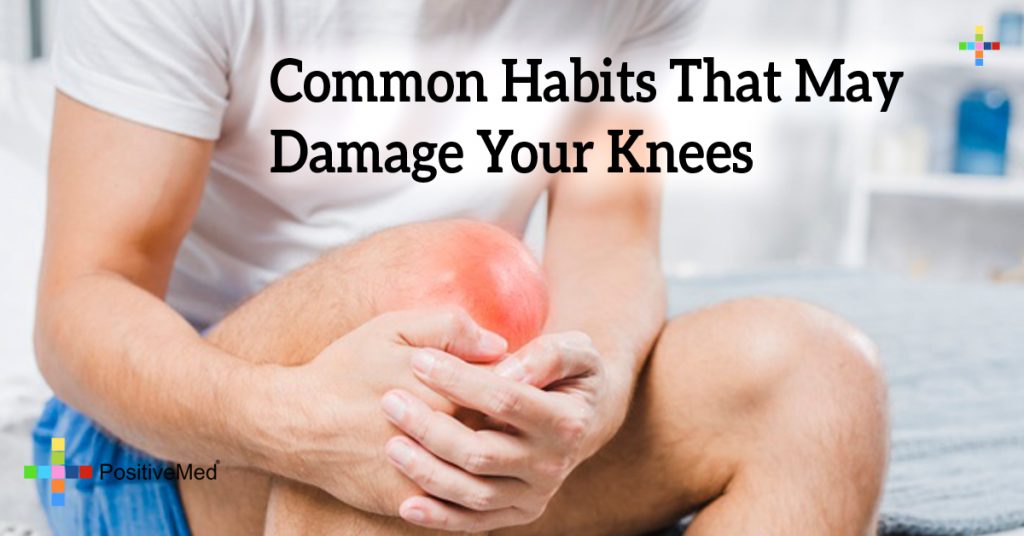
Common Habits That May Damage Your Knees
“Hello, it’s me, your knee. On behalf of your body, I need to tell you there’s a grave situation going on down here.” Sometimes our knees talk to us, don’t they? They may warn us of an impending injury, and message us in advance. Other times, there’s a sudden outburst from our knees. “Mayday! Mayday!” they may say.
In this article, we’ll discuss common knee injuries. We’ll highlight causes, symptoms, and treatments for each condition. Then we’ll share exciting information about foods that decrease pain.
ACUTE KNEE INJURY
This is the sudden injury, the one that catches us by surprise.
1. MENISCAL TEAR
Anatomy: Two cushioning structures sit atop the lower leg, acting like shock absorbers. They’re termed cartilage or “menisci.”
Cause: Twisting movement of the knee. This injury is common to sports, when a player sharply pivots or lands hard on a bent knee. A meniscal tear can also occur with age, when the cartilage thins and weakens.
Symptoms: A pop in the knee. Over the next 2-3 days, the knee becomes stiff and swollen. The knee can lock. You may feel you can’t fully straighten your knee.
Treatment: A tear to the outer red zone, which has a good blood supply, may heal by itself. You can help things along with the “RICE” treatment: Rest, Ice, Compression, and Elevation. Your doctor may also prescribe physical therapy to restore joint movement and muscle strength. If the tear involves the inner zone of the meniscus, which is not nourished by blood, surgery is necessary.
Moral of the Story: Guard your knee against meniscal injury by strengthening the muscles around the knee. Wearing a brace or elastic band while playing a sport provides extra protection.
2. ANTERIOR CRUCIATE LIGAMENT TEAR
Anatomy: A ligament is a fibrous band that connects two bones. The anterior cruciate ligament (ACL) runs diagonally through the inside of the knee. It keeps the lower leg from sliding in front of the thigh. Injury to the ACL can take the form of a sprain or tear.
Cause: An ACL tear typically occurs in sports when an athlete suddenly stops and changes direction, incorrectly lands after a jump, or collides with another player.
Symptoms: The knee will buckle. There may be a complete loss of knee function. The pain of injury is severe, followed by massive swelling.
Treatment: The majority of ACL tears require surgery, followed by bracing and physical therapy. Surgery involves ACL replacement with a graft ligament held in place with screws.
Moral of the Story: You can reduce the risk of an ACL tear by engaging in training drills to promote power, proper form, agility, and balance. An ACL Injury Prevention Program can be administered by a coach or sports physical therapist.
3. MEDIAL COLLATERAL LIGAMENT INJURY
Anatomy: The medial collateral ligament (MCL) is located on the inside of the knee, and connects the upper and lower leg bones. It stabilizes the knee from the side. Let’s refer to the previous image to view the MCL:
Cause: A blow to the inside of the knee can sprain the MCL.
Symptoms: Considerable pain at the inner knee, followed by buckling. The knee swells and feels unstable.
Treatment: An MCL sprain is treated with our friend, Mr. RICE. Wearing a knee immobilizer may also be required. Physical therapy targeting the knee is helpful for strengthening the joint. Tear of the MCL is rare, but when it occurs, surgery may be necessary.
Moral of the Story: Wear a knee support when playing your game.
CHRONIC KNEE INJURY
This is the injury that brews behind the scenes and lingers.

1. RUNNER’S KNEE
Anatomy: Runner’s knee is a catch-all phrase that refers to several conditions that cause knee pain. The thigh bone and kneecap are involved. This condition is the most common type of knee pain seen by doctors.
Cause: The cause is multifactorial, including kneecap misalignment, cartilage breakdown, and flat feet. Other contributory elements are insufficient stretching before exercise and muscle overuse.
Symptoms: Achy pain beneath and around the front of the kneecap. It occurs with climbing stairs, squatting, kneeling, and sitting for an extended period with the knee bent.
Treatment: RICE. Wear shoes appropriate to your activity. If you have flat feet, wear arch supports within your shoes. Prior to exercising, stretch your muscles, and do a 5-minute walk to warm up. Physical therapy can target treatment to the causes with strengthening exercises, taping, and bracing.
Moral of the Story: Do adequate preparation for your sport or exercise. Use good form.
2. SHIN SPLINTS
Anatomy: Shin splints involve the lower leg.
Cause: Inflammation of the muscles along the lower leg from overuse and repetitive activity. You can be predisposed to shin splints if you have flat feet or very high arches. Improper footwear is a contributing factor.
Symptoms: Pain, swelling, and tenderness along the lower leg.
Treatment: RICE and stretching the knee muscles. Lower-impact activity can substitute for your preferred exercise as you heal. Examples are using a stationary bike and swimming. Supportive, cushioned shoes reduce stress to the lower leg. Orthotics can correct arch problems.
Moral of the Story: If you suffer from shin splints, prepare before exercising, and go easier.
3. ARTHRITIS
Anatomy: Cartilage at the ends of the leg bones wears down with age. Menisci thin. Bones can develop spurs that irritate soft tissues surrounding the knee. The lubricating fluid with the joint diminishes.
Cause: Joint space narrowing from thinning cartilage creates friction against bones. Spurs compound the friction. Less joint fluid prevents knee structures from moving smoothly.
Symptoms: Joint stiffness, pain, and impaired movement.
Treatment: Gentle exercise decreases stiffness and improves function. Examples are stationary biking, walking, and swimming. There are many foods that decrease inflammation and pain, as we’ll describe below.
Moral of the Story: Don’t get old. No, just kidding! Aging is inevitable. However, following the above suggestions can slow down the process and relieve the symptoms of arthritis.
FOODS THAT DECREASE PAIN
There are many dietary tweaks that can prevent and decrease knee pain. Certain foods have anti-inflammatory and pain-relieving effects. Some of them work as well as medications.
1. Fish – Omega-3 fatty acids in fish can dial down soreness, stiffness, and pain. Fish that are particularly high in omega-3’s are tuna, salmon, herring, and cod. You can also take fish oil supplements.
2. Oranges – Vitamin C protects against the bone degeneration and pain of arthritis. Potent sources are oranges, strawberries, grapefruit, and green peppers.
3. Spinach – Popeye had it right. Antioxidants in spinach can help relieve arthritis pain. Antioxidants are chemicals that prevent or slow down cellular damage.
4. Apples, Onions, Red Grapes, and Tea – These are all rich in quercetin, a natural chemical with anti-inflammatory effects.
5. Spices – Curcumin in turmeric reduces levels of an enzyme responsible for pain and swelling. Ginger is a natural inflammatory and pain-reliever.

CONCLUSION
It is hoped that by following some of the above suggestions, you can be relieved of knee pain, enjoy a better quality of life, and hear happier comments from your knees.





